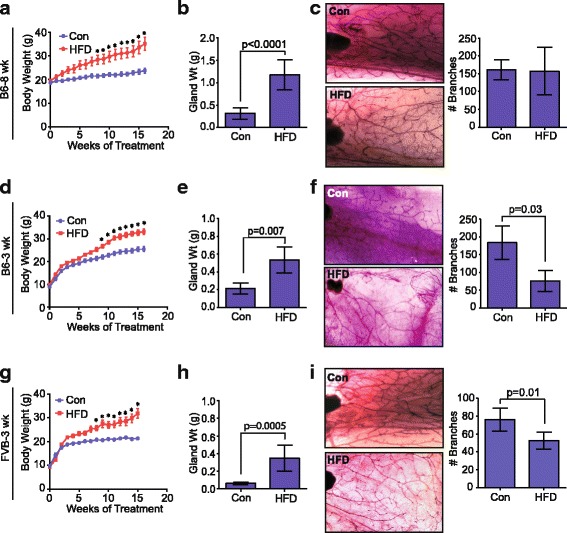Fig. 3.

High-fat diet (HFD) feeding during puberty reduces ductal branching. a C57Bl/6 female mice were fed a HFD or control diet (Con) starting at 8 weeks of age (B6-8 wk). Weight was determined weekly for 17 weeks (n = 7 mice/group; mean ± s.e.m.). Significance was determined using two way analysis of variance (ANOVA) (*p < 0.05). b Weights (Wt) of inguinal mammary glands from Con and HFD-fed B6-8 wk mice after 17 weeks on the diets (n = 7 mice/group). c Mammary gland whole mounts of inguinal mammary glands from Con and HFD-fed B6-8 wk mice. Tertiary branches were counted in both groups (n = 5 mice/group). d C57BL/6 female mice were fed HFD or Con starting at 3 weeks of age (B6-3 wk) for 17 weeks (n = 9 mice/group; mean ± s.e.m.). Significance was determined using two way ANOVA (*p < 0.05). e After 17 weeks, inguinal mammary glands were weighed from B6-3 wk mice (n = 9 mice/group). f Mammary gland whole mounts of inguinal mammary glands from B6-3 wk mice. Tertiary branches were counted in both groups (n = 5 mice/group). g FVB/N female mice were fed a HFD or Con starting at 3 weeks of age (FVB-3 wk) for 17 weeks (n = 9 mice/group; mean ± s.e.m.). Significance was determined using two way ANOVA (*p < 0.05). h After 17 weeks, inguinal mammary glands were weighed from FVB-3 wk mice (n = 9 mice/group). i Mammary gland whole mounts of inguinal mammary glands from Con and HFD-fed FVB 3-wk mice. Tertiary branches were counted in both groups (n = 5 mice/group). Bars represent mean ± s.d. Magnification of images × 10
